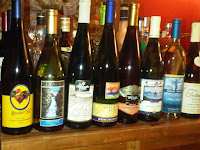- Dr. Frank's Vinifera Wine Cellars 2011 Gruner Veltliner
- Glenora Wine Cellars 2011 Pinot Blanc
- King Ferry Winery 2010 Reserve Chardonnay Cayuga Lake
- Goose Watch Winery 2011 Pinot Grigio
- Sheldrake Point Winery 2011 Gewurztraminer
- Seneca Shore Wine Cellars 2010 Dry Gewurztraminer
- Rooster Hill Vineyards 2010 Estate Gewurztraminer
- Wagner Vineyards 2010 Gewurztraminer Semi-Dry
We started the tasting with the non-gewurztraminers, appropriately with the Dr. Frank's Vinifera Wine Cellars 2011 Gruner Veltliner. Dr. Frank's pioneered the growing of vinifera grapes in the Finger Lakes and the GV is the latest in their portfolio. This was an enjoyable wine, balanced between fruit and acids, plus a nice texture that guides you from the head to the tail.
The 2010 Grüner Veltliner fits perfectly within the Dr. Frank family of wines. The wonderful nose is a treat of floral, melon and honeysuckle while the mouth has subtle herbal notes and balanced layered textures in the background that finish off with the typical Grüner Veltliner white pepper heat. It is food friendly wine and pairs well with everything from scallops and roasted vegetables to grilled pork tenderloin.” – Winemaker’s Notes
The Glenora Wine Cellars 2011 Pinot Blanc was lighter, but had a similar balance and hits home when paired with food. The wine was barrel fermented, but the oak adds texture and doesn't overshadow the fruit.
Pinot Blanc shows finesse and elegance, with a full, lingering finish. Barrel fermentation allows a balance of oak and fruit on the palate. – Winemaker’s Notes
The King Ferry Winery 2010 Reserve Chardonnay Cayuga Lake was produced in true Burgundian style, inoculated with yeast and malolatic cultures, then barrel fermented, and finally aged "sur lees". For my palate, this processed introduced too much oak and butter into the wine which seemed to overwhelm the fruit. I know its a style many enjoy, just not my taste
Aromas of fresh-baked bread, cheese, and honey, followed by a smooth yet substantially oaked body with a creamy texture and hints of vanilla. Finishes long with toasted almond and a tahini tang. – Winemaker’s Notes
I normally avoid Pinot Grigio as much as possible, basically being extremely indifferent to this varietal wine. Why drink it when there are so many other more interesting whites available? That thought process was shaken by the Goose Watch Winery 2011 Pinot Grigio. There was nothing boring about this wine, it had flavor, texture, and yes, some creaminess. The secret may be that the wine is not 100% Pinot Grigio, but 75% - enough to label the wine as a single varietal. In addition, it contains 10% Riesling and Chardonnay as well as 5% Vignoles. Maybe this 25% adds the necessary attributes to elevate the Pinot Grigio above dullness.
Ripe yellow apple and pear aromas with a hint of dried fruit and clove. Broad mid palate with hint of cream in the finish. – Winemaker’s NotesI will follow up later with my thoughts on the Gewurztraminer, but in the meantime, here's the link to the recorded live stream. Cheers.
http://www.ustream.tv/channel/finger-lakes-wine-virtual-tasting-series




































